 (Article taken from USEPA – Composting at Home (https://www.epa.gov/recycle/composting-home) and Ohio EPA Citizens Guide to Composting - https://epa.ohio.gov/portals/47/facts/citizens_guide_to_composting.pdf ) During this unusual and challenging year many of us have looked for new hobbies to fill our time. Composting is a hobby that is not only fun, but it is beneficial to the soil and your wallet! Composting is nature’s way of recycling leaves, grass clippings, kitchen scraps and other organic wastes by converting them into a valuable soil amendment called compost. By composting at home, you’ll enjoy the financial benefits of free soil enrichment, reduce the amount of solid wastes sent to landfills and conserve resources. Compost is organic material that can be added to soil to help plants grow. Food scraps and yard waste together currently make up more than 28 percent of what we throw away, and should be composted instead. Making compost keeps these materials out of landfills where they take up space and release methane, a potent greenhouse gas. Composting at home is very easy and practical. Once you learn the basics, you’ll be turning out lush piles of rich compost in short order. Using compost yields faster-growing, stronger plants. The chief value in using compost is the beneficial effect on soil structure. Incorporating compost into the soil improves aeration and drainage and makes the soil loose and easy to work. Compost increases the organic matter content of clay and sandy soils, allowing them to better retain water and nutrients. It also helps control erosion, proper pH balance and plant disease. All composting requires three basic ingredients:
What To Compost
What Not To Compost and Why
Selecting and Building your Composting Site
Compost can be made in just two or three weeks during the summer if the leaves and other materials are finely ground or shredded, turned frequently to provide good aeration and supplied with sufficient moisture and nitrogen.
For more questions regarding Warren County Soil and Water Conservation District programs and/or technical assistance on water or soil questions, visit http://warrenswcd.com or call, 513-695-1337.
2 Comments
Soil tests are an essential part of farming and gardening because they can help determine plant nutrient needs and plant selection decisions thus helping to keep money in your pocket. Testing soil has often been compared to visiting a doctor for a health check-up. Physicians use tests to help them prescribe medications and the same should be done for our soil. Having too much of one nutrient can affect our crops badly and affect the productivity, on the other hand not having enough nutrients to sustain plants can be detrimental to the crop. Whether you are a wanting to grow a small vegetable garden or a thousand acres of corn; soil testing is a good thing to give you a basis on where to start. Testing soil helps to keep the soil healthy by measuring what is exactly in the soil. Soil labs then give recommendations on what to apply to ensure excess nutrients are not available to escape into groundwater, streams and lakes where they contribute to environmental problems (i.e. algal blooms, hypoxia, etc.). A big water quality issue in the State of Ohio that is affecting not only lake Erie but inland lakes such as Buckeye Lake, Grand Lake St. Marys and even Caesar Creek is excess phosphorus. It is important that phosphorus is not added if the soil does not need it. In many parts of the country fertilizer companies are not including phosphorus in their mixes to ensure phosphorus is not over applied. Soil sampling can be done any time of the year but it is best not to take samples in high rain events. One test can be taken for an area if there are no major topography changes or the area has not been treated differently in the past (I.e. pasture in one area of the field and crops in the other area). It is recommended that a separate test be taken in that area that was managed differently so that results are not skewed. It is also recommended to lump no more than 20 acres together in one test.
The field should be walked in a zig-zag pattern, with a subsample taken every few feet. For small areas such as vegetable garden, 5-10 subsamples are sufficient and 10-15 subsamples for larger areas such as lawns and fields. Subsample depths should be taken at the following:
As the arboreal leaves turn vibrant reds and oranges, some of us may be noticing a browning in our backyard gardens as tomato and pepper plants are coming to the end of their season. Depending on the weather, October can be an ideal time in Ohio to keep giving your garden a little bit more love and attention. And set your gaze on next season's success!
Fall garden basics:
Gardening is a wonderful way to connect with the outdoors and provide local sustenance, And by following conservation gardening techniques, you can maximize your garden yield while working in harmony with the local environment!  Natural Resources Conservation Service LEBANON SERVICE CENTER 777 COLUMBUS AVE STE 3A LEBANON, OH 45036-1682 (513) 282-2957 Program Contact: Beth Lessick District Conservationist Phone: 513-282-2955 Email: Elizabeth.Lessick@oh.usda.gov The U.S. Department of Agriculture's Natural Resources Conservation Service (NRCS) announced Friday, October 19, 2018, as the deadline to submit applications for the Environmental Quality Incentives Program (EQIP) in Ohio. EQIP is a voluntary conservation program which helps producers make conservation work for them. Together, NRCS and producers invest in solutions that conserve natural resources for the future while also improving agricultural operations. Through EQIP, NRCS provides agricultural producers with financial resources and one-on-one help to plan and implement improvements, or what NRCS calls conservation practices. Using these practices can lead to cleaner water and air, healthier soil and better wildlife habitat, all while improving agricultural operations. Through EQIP, you can voluntarily implement conservation practices, and NRCS co-invests in these practices with you. Financial assistance is now available in a variety of agricultural categories such as cropland, forestry, pasture operations, and organic. Several special projects are also available which address water quality, forestry management, improving pollinator populations, applying best management practices and many more. All available agricultural categories are listed on the Ohio NRCS website under “EQIP Application Deadlines.” To participate in USDA conservation programs, applicants should be farmers or farm or forest landowners and must meet eligibility criteria. Applications signed and submitted to NRCS by the October 19 deadline will be evaluated for fiscal year 2019 funding. To learn more about EQIP or other technical and financial assistance available through NRCS conservation programs, visit Get Started with NRCS or visit your local USDA Service Center. Web: www.oh.nrcs.usda.gov April showers bring May flowers, and now is the time to start thinking about getting your soil tested! Getting your soil tested helps you find out what your lawn and garden needs and ensures that you are not over fertilizing or hurting your plants. Over fertilizing means you are putting more nutrients into your soil than your plant needs to survive. So instead of being used, the nutrients get carried away by runoff and cause pollution problems in lakes, streams, and even groundwater.
Did you know that the major cause of algae blooms is too many nutrients in the water? We all have a responsibility to help reduce the likelihood of harmful algal blooms in places like the Little Miami River, Caesar's Creek Lake, Landon Lake, and other ponds, lakes, and streams in our community. Before you head out to shop for your outdoor landscape this spring, consider purchasing a soil test from us here at the Soil & Water Conservation District. Or, if you have a lawn service, make sure they conduct a soil test before adding anything to your lawn. Warren Co SWCD sells soil test kits - find out more here: https://www.warrenswcd.com/soil-testing.html Some of the questions we often get are listed below: How do I take a soil sample?
What does it test for? Your soil test will determine the soil nutrient levels for pH, Phosphours (P), Potassium (K), and Magnesium (Mg). The test will also let you know if you are below optimum, optimum, or above optimum for each of these nutrients. You will also get information on Calcium and the Cationic Exchange Capacity (CEC). Soils with a high CEC will remain fertile over a longer period of time, requiring fewer fertilizer applications. Soil pH will determine the way nutrients are made available to the plants. Why doesn't it test for Nitrogen? Nitrogen moves quickly through the soil, and some forms dissolve easily in water and are carried away with runoff. By the time your soil sample reaches the lab and they analyze it, the level of nitrogen is no longer what it was when you took the sample so the reported number would not be accurate. However, you will receive information on nutrient needs for Nitrogen, Phosphate, and Potassium based on your test results. Why should I test for organic matter? Generally, soil is made up of 45% minerals (rocks), 25% water, 25% air and 5% organic matter. The organic matter is the decomposing plant and animal material inside your soil and will range anywhere from 1-6% of the soil composition. Organic matter is very important to plant nutrition. Organic matter results in less soil compaction, allowing more air to pass through and increased water storage. Recommendations:
When will I receive my test results? You will receive an email with your results within 10 days after your sample is received by the lab. Without an email address, the results may take slightly longer by mail. What do I do once I receive the results? Your soil test report from MSU will provide you with recommendations on nutrient needs and fertilizer options based on your test results. Make sure you provide the lab with as much information about the test area as you can so they can provide more specific options. You can also go to their website: http://www.msusoiltest.com/understand-your-soil-test/ and type in your soil test details to receive a specific fertilizer ratio for N, P, and K. Do I need to fertilize? Not necessarily. One of the best fertilizers for your soil is compost! And once you have a container, it is free to make. You can also leave your grass clippings on your lawn after you mow to provide your grass with a ready source of fertilizer and help keep moisture on your lawn. Give us a call at the OSU Extension office: 513-695-1853 or Soil and Water Conservation District at 513-695-1337 for more assistance. Happy Spring! Information for this blog post was provided by Michigan State University Extension, the Ohio State University Extension and Hamilton County Soil and Water Conservation District. |
Details
Warren County SWCD Staff BlogA blog to keep you informed on all the latest news at Warren County SWCD and in the conservation world. Archives
May 2024
Categories
All
|
|
|
Contact:PHONE: (513) 695 - 1337
EMAIL: [email protected] HOURS: Monday - Friday 7:30am - 4:00pm (except holidays) Connect:Warren County Soil & Water Conservation District Copyright © 2016
Warren SWCD Privacy Notice. Emails are serviced by Constant Contact. Constant Contact's Privacy Notice. |




